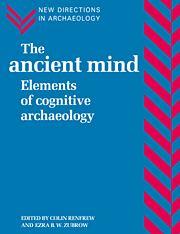Book contents
- Frontmatter
- Contents
- List of figures
- List of tables
- List of contributors
- Preface
- PART I INTRODUCTION
- PART II THE INTERDISCIPLINARY UNDERPINNING
- PART III APPROACHES TO CULT PRACTICE AND TRANSCENDENTAL BELIEF SYSTEMS
- PART IV PREHISTORIC CONCEPTIONS OF SPACE AND TIME
- PART V THE MATERIAL BASIS OF COGNITIVE INFERENCE: TECHNOLOGY
- 13 Cognitive aspects of ‘technique’
- 14 Mindful technology: unleashing the chaîne opératoire for an archaeology of mind
- 15 Prehistoric technology: a cognitive science?
- PART VI THE MATERIAL BASIS OF COGNITIVE INFERENCE: WRITING SYSTEMS
- PART VII CONCLUSION
- Index
15 - Prehistoric technology: a cognitive science?
Published online by Cambridge University Press: 03 December 2009
- Frontmatter
- Contents
- List of figures
- List of tables
- List of contributors
- Preface
- PART I INTRODUCTION
- PART II THE INTERDISCIPLINARY UNDERPINNING
- PART III APPROACHES TO CULT PRACTICE AND TRANSCENDENTAL BELIEF SYSTEMS
- PART IV PREHISTORIC CONCEPTIONS OF SPACE AND TIME
- PART V THE MATERIAL BASIS OF COGNITIVE INFERENCE: TECHNOLOGY
- 13 Cognitive aspects of ‘technique’
- 14 Mindful technology: unleashing the chaîne opératoire for an archaeology of mind
- 15 Prehistoric technology: a cognitive science?
- PART VI THE MATERIAL BASIS OF COGNITIVE INFERENCE: WRITING SYSTEMS
- PART VII CONCLUSION
- Index
Summary
It is now well known that the appearance of tools precedes that of man, and furthermore, that tools are not the exclusive attribute of the Hominidae. Recent research in animal behaviour shows that many species, not only our closest ‘cousins’ the chimpanzees and other great apes, are capable of selecting a branch or a stone to obtain food which is not directly accessible to them and that, in some cases, they may go elsewhere to look for a suitable instrument, or put it aside for later use. Memory, the choice of a suitable instrument, and the medium-term retention of information are the intellectual faculties necessary for the construction of a chaîne opératoire. It seems, however, that only some of the great apes are capable of making or reworking a tool (Beyries and Joulian 1990).
The chaîne opératoire, however, is not limited to the domain of tools: the building of a nest or a beaver lodge, and the hoarding of food supplies for hibernation, are other examples. The behaviour of certain animal species thus reveals systems of technology which have to be compared with those of humans if we wish to understand what distinguishes innate and learned capabilities. The study of the slow evolution of human intelligence over three million years is clearly one of the research directions which the cognitive sciences must explore in order to understand the dialectical relationship between intellectual activities, which we define as logically-based (analysis of information by induction and deduction), and those which are non-logical (coding of information based on perception and memory, selection, comparison, recoding, etc.).
- Type
- Chapter
- Information
- The Ancient MindElements of Cognitive Archaeology, pp. 152 - 164Publisher: Cambridge University PressPrint publication year: 1994
- 21
- Cited by

